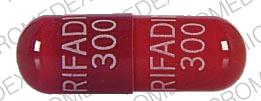Rifadin Dosage
Generic name: RIFAMPIN 600mg in 10mL
Dosage form: capsule, injection
Drug class: Rifamycin derivatives
Medically reviewed by Drugs.com. Last updated on May 14, 2025.
Rifampin can be administered by the oral route or by IV infusion (see INDICATIONS AND USAGE). IV doses are the same as those for oral.
See CLINICAL PHARMACOLOGY for dosing information in patients with renal failure.
Tuberculosis
Adults: 10 mg/kg, in a single daily administration, not to exceed 600 mg/day, oral or IV
Pediatric Patients: 10–20 mg/kg, not to exceed 600 mg/day, oral or IV
It is recommended that oral rifampin be administered once daily, either 1 hour before or 2 hours after a meal with a full glass of water.
Rifampin is indicated in the treatment of all forms of tuberculosis. A three-drug regimen consisting of rifampin, isoniazid, and pyrazinamide is recommended in the initial phase of short-course therapy which is usually continued for 2 months. The Advisory Council for the Elimination of Tuberculosis, the American Thoracic Society, and the Centers for Disease Control and Prevention recommend that either streptomycin or ethambutol be added as a fourth drug in a regimen containing isoniazid (INH), rifampin, and pyrazinamide for initial treatment of tuberculosis unless the likelihood of INH resistance is very low. The need for a fourth drug should be reassessed when the results of susceptibility testing are known. If community rates of INH resistance are currently less than 4%, an initial treatment regimen with less than four drugs may be considered.
Following the initial phase, treatment should be continued with rifampin and isoniazid for at least 4 months. Treatment should be continued for longer if the patient is still sputum or culture positive, if resistant organisms are present, or if the patient is HIV positive.
Preparation of Solution for IV Infusion
Reconstitute the lyophilized powder by transferring 10 mL of sterile water for injection to a vial containing 600 mg of rifampin for injection. Swirl vial gently to completely dissolve the antibiotic. The reconstituted solution contains 60 mg rifampin per mL and is stable at room temperature for up to 30 hours. Prior to administration, withdraw from the reconstituted solution a volume equivalent to the amount of rifampin calculated to be administered and add to 500 mL of infusion medium. Mix well and infuse at a rate allowing for complete infusion within 3 hours. Alternatively, the amount of rifampin calculated to be administered may be added to 100 mL of infusion medium and infused in 30 minutes.
Dilutions in dextrose 5% for injection (D5W) are stable at room temperature for up to 8 hours and should be prepared and used within this time. Precipitation of rifampin from the infusion solution may occur beyond this time. Dilutions in normal saline are stable at room temperature for up to 6 hours and should be prepared and used within this time. Other infusion solutions are not recommended.
Meningococcal Carriers
Adults: For adults, it is recommended that 600 mg rifampin be administered twice daily for two days.
Pediatric Patients: Pediatric patients 1 month of age or older: 10 mg/kg (not to exceed 600 mg per dose) every 12 hours for two days.
Pediatric patients under 1 month of age: 5 mg/kg every 12 hours for two days.
Preparation of Extemporaneous Oral Suspension
For pediatric and adult patients in whom capsule swallowing is difficult or where lower doses are needed, a liquid suspension may be prepared as follows:
RIFADIN 1% w/v suspension (10 mg/mL) can be compounded using one of four syrups–Simple Syrup (Syrup NF), Simple Syrup (Humco Laboratories), SyrPalta® Syrup (Emerson Laboratories), or Raspberry Syrup (Humco Laboratories).
- Empty the contents of four RIFADIN 300 mg capsules or eight RIFADIN 150 mg capsules onto a piece of weighing paper.
- If necessary, gently crush the capsule contents with a spatula to produce a fine powder.
- Transfer the rifampin powder blend to a 4-ounce amber glass or plastic (high density polyethylene [HDPE], polypropylene, or polycarbonate) prescription bottle.
- Rinse the paper and spatula with 20 mL of one of the above-mentioned syrups and add the rinse to the bottle. Shake vigorously.
- Add 100 mL of syrup to the bottle and shake vigorously.
This compounding procedure results in a 1% w/v suspension containing 10 mg rifampin/mL. Stability studies indicate that the suspension is stable when stored at room temperature (25±3°C) or in a refrigerator (2–8°C) for four weeks. This extemporaneously prepared suspension must be shaken well prior to administration.
Frequently asked questions
- Do antibiotics affect the morning after pill?
- Can antibiotics delay or make your period late?
- How long do antibiotics affect birth control?
More about Rifadin (rifampin)
- Check interactions
- Compare alternatives
- Reviews (1)
- Drug images
- Side effects
- During pregnancy
- Generic availability
- Drug class: rifamycin derivatives
- Breastfeeding
- En español
Patient resources
Other brands
Professional resources
Other formulations
Related treatment guides
See also:
Further information
Always consult your healthcare provider to ensure the information displayed on this page applies to your personal circumstances.


